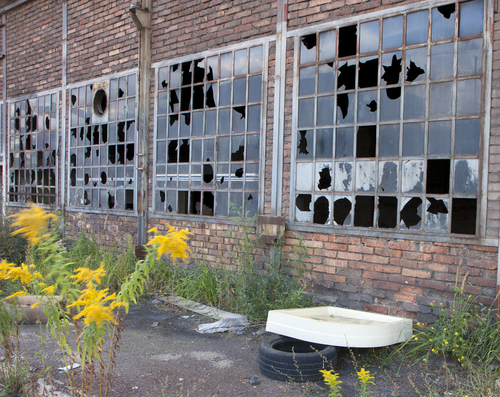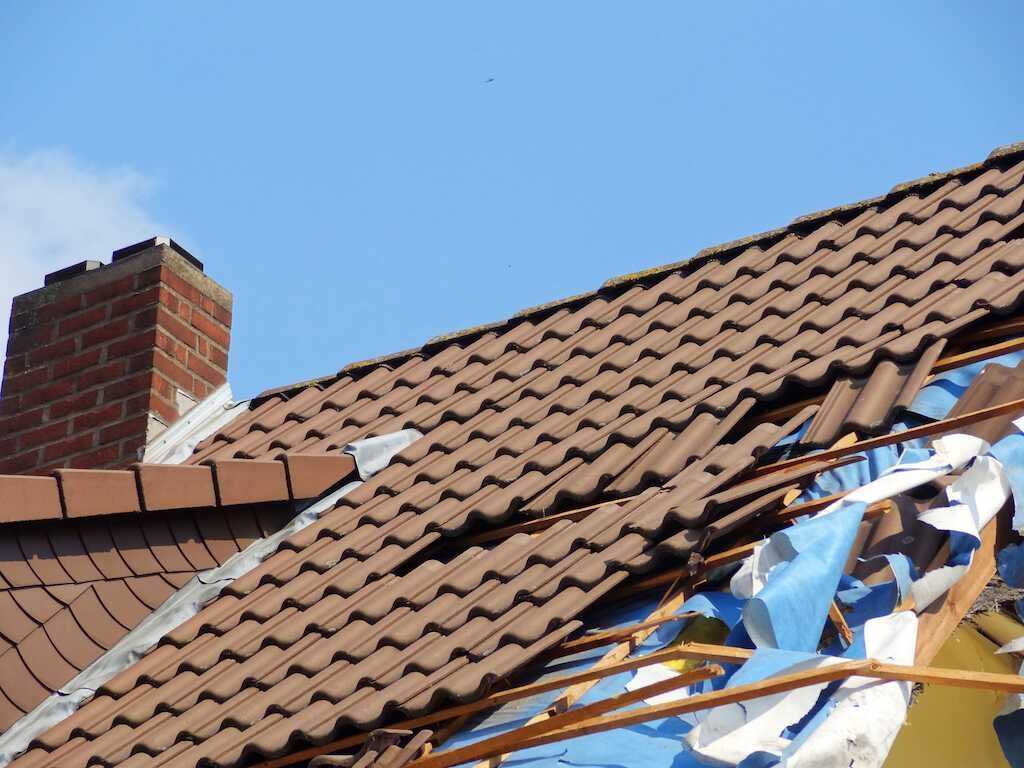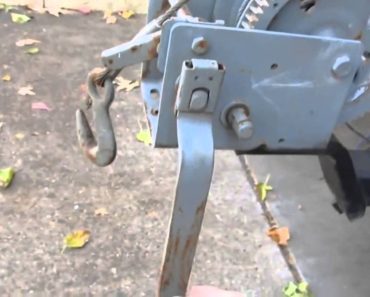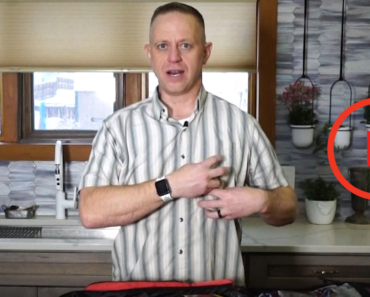The shelter is commonly understood to be one of the most important survival priorities. We talk about bugging in rather than bugging out because we have our home to use as shelter.
When bugging out, building a shelter is one of the first things to establish camp. Regardless of where we are, we need shelter to protect us from the weather and ensure our survival.
But what about when our home becomes damaged in a disaster; does bugging out become our only viable option? Would we be forced to abandon everything we own just because a hurricane dropped a tree on our roof? Can we still use our homes as shelter, even though they are damaged?

First, we need to understand that much of the world still live in homes that aren’t anywhere near to being up to our standards. That was the norm throughout most of world history. Our modern building code doesn’t allow it here in the US, with regulations that are mainly aimed at making our homes safe in pretty much any circumstance. But that doesn’t mean that we couldn’t live in them if they weren’t up to that standard.
After a disaster, granted the city code inspector might come around, checking homes and declaring them unfit to live in. Should they condemn your home, you may be forced to vacate it. But leaving that aside, as they might not get to you, it’s up to you whether your home or even part of your home is still livable.
Whether you stay in your home or you leave, the decision you make at this point is based upon two things: the condition of your home and what your other options are. If you leave a home that a tree fell on and end up on the street, you’re worst off, not better off. Besides, leaving your home vacant opens up the opportunity for looters to get into it and take everything of value. That alone is an excellent reason to try and stay in your home if you can.
Start with an Inspection
The starting point on deciding to stay or leave your home is different in this situation than in another bug-out scenario, although the motive is the same. Again, you’re trying to decide what’s best for your family’s safety, except in this case, it’s not due to outside influences but in the condition of your home.
Before concerning ourselves with physical damage to the home, we need to look at safety, specifically fire safety. Are there any bare wires exposed, not insulated ones, but bare ones, making sparks? That’s a definite fire hazard. Is there the smell of natural gas or propane (if you have a propane tank)? That’s even more dangerous than the sparks, as escaping gas can explode. While you’re looking at those things, look for leaking water too. That might not be a safety issue for you, but it might be one for the community if enough people have water leaks to drop the pressure in the lines and deny firefighters the water they need.
You should know where all the shutoffs for your home are; water, gas, and electric. If a unique tool is needed for shutting any of them off, make sure you have one and that it’s located where it is easy to find. If your breaker box isn’t properly labeled so that you know what all the breakers are for, take the time to figure it out and mark it properly so that you can quickly and easily shut off breakers to damaged areas of your home.
Knowing how to shut off the power, water, and gas yourself is the fastest and surest way of eliminating any safety risks posed by exposed wiring and broken pipes. But, unfortunately, having to wait for a professional to come over and do it means allowing those electrical sparks and that escaping gas to start a fire and burn down the rest of your home, along with all your belongings.
But your inspection doesn’t end with checking the gas and water. That’s just the first step. The next thing to do is to see how much damage has been done to your home. We’re concerned about two things here: structural damage and damage that can let the weather in.
Shelter, by definition, is there to protect us from three basic things: rain, wind, and cold. A roof over your patio protects you from the rain, but not wind or cold. So it is only limited shelter. Even that is good, although a complete shelter would be better.
Broken windows allow wind and rain into the home while allowing heat to escape. So unless they can be fixed in some way, they render the room they are in uninhabitable. Likewise, that tree falling on the roof can cause sufficient damage that rain could get into the home, rendering some parts of the home inhabitable until the roof is repaired or at least covered over.
But that tree does more than damage the roof, allowing water into the home. It will probably do some structural damage as well. The risk here is that the damage is severe enough that the tree might slip down further, minutes or even days later, crushing someone underneath it.
It is pretty easy to determine the extent of that tree’s damage to your home. The thing you want to look for is how far down the damage comes. For example, if you can see where part of the tree is coming through the wall and not just through the roof, there is severe structural damage to the wall; serious enough, you must consider that the tree could fall further.
Don’t get distracted by cosmetic damage. The drywall covering a home’s interior walls and the siding covering the outside of those walls aren’t solid. It can easily be destroyed while leaving the structural components intact. You’ve got to see past the cosmetic and focus on the structure.
The structure hidden inside your home’s walls is built something like a wide ladder, lying on its side. There’s a horizontal piece across the top and another across the bottom. But in-between that, there are just a series of “rungs,” called studs, which can’t stop the tree from falling further because they are running vertically. So if the tree has managed to break through the piece across the top of the wall, there’s nothing of substance to stop it until it reaches floor level.
On the other hand, if the tree was stopped by the horizontal piece at the top of the wall (called the top plate), the studs will hold the wall top plate in place, and it is unlikely that the tree will fall any further. For the tree to do that would require the weight of the tree pushing the wall sideways to bulge outward, weakening the wall.
Once you’ve determined which parts of the house have been compromised structurally, you’ll know which parts are still available for use. Of course, chances are you’ll have to do some reorganizing, having family members sleep in different rooms, and doing family activities in places other than the norm. However, you’ll still be able to live in your home while you’re going about getting it repaired.
Emergency Repairs to Your Home
There are two levels of home repair needed when a natural disaster damages a home. The first level is the emergency repairs to make it possible to continue using your home. These repairs are all about making your home function as a shelter and may not be attractive. But they are only temporary. The second level is when the professionals come in and do whatever is necessary to return your home to how it was before it became damaged.
While there will probably be professional tradesmen in the area, going from home to home and conducting emergency repairs, you don’t need to wait for them. Not only could that take longer, but your insurance isn’t going to pay for both the emergency repairs and the restoration of your home. Having them pay for emergency repairs, which are always overpriced, may mean that you won’t have the necessary money from your insurance to complete the restoration work.
Fortunately, emergency repairs are something you can do pretty quickly, even if you’re not an expert carpenter, plumber, or electrician.
Roof Damage
Roof damage can happen with something as small as a hailstorm, let alone more significant natural disasters. The damage can either be shingles torn off the roof by high winds or holes made by falling objects. In either case, the goal is to keep water from getting past the shingles and damaging the home.
That is most easily accomplished by covering the damaged area with a tarp. The cheap blue plastic tarps are most commonly used for this purpose. They need to be nailed down with something under the nail heads, keeping them from pulling through. It’s also necessary to ensure that the tarp (or multiple tarps) goes over the roof’s ridge to ensure that water falling on the upper part of the roof can’t seep under the tarp. Finally, make sure the tarp is pulled taut so that wind doesn’t rip it.
Covered in this way, a home can sit for months before the roofers come and repair the damage. First, however, the tarps should be checked periodically to ensure they aren’t damaged.
Damage to Walls
Wall damage is hard to repair, but it is easy to extend the tarps talked about above so that they cover that damage as well, keeping rain and wind from coming through the wall.
If a tree has fallen on the home and it appears that the wall is damaged, it might be a good idea to provide some support under the branch or trunk. For this, you’ll need some 2″ x 4″ s. Cut to length so that the piece can sit strictly vertically under the trunk or branch for the most strength, with a 2″ crossbar at the bottom, also cut from a 2″ x 4″. Nail the wood pieces to each other, the floor, and the tree so that they won’t slip accidentally.
Broken Windows
Windows can easily be covered with clear plastic, what contractors refer to as “Visqueen,” and many other people think of plastic drop cloths for painting. However, it’s better to use thicker plastic than thin, as it is much less likely to be blown apart by the wind.
The plastic can be attached with duct tape if there is a clean, dry surface to tape to. If not, it will need to be nailed or stapled in place. But just like the tarps on the roof, the nails will need something under their heads to keep them from tearing through the plastic. Again, either wood or cardboard strips (not corrugated cardboard, but rather drywall shims) will work for this.
Broken, Leaking Water Lines
Shutting off the water at the home’s main water valve, where the water comes into the house, or at the water meter will stop the leak, but that will leave you without water. So while you might do that temporarily, you’re better off capping the broken water line so that you can turn the water back on.
Fortunately, most homes today have PVC plastic water lines, which are easy to cap. Just cut off the pipe short of where the leak occurs, then glue the appropriate size cap on, using PVC primer and PVC cement. Note that the cement doesn’t work well without the primer. While it might be necessary to cap several lines, you should still have water to some faucets in your home.
Gas Leaks
Gas leaks are dangerous and shouldn’t be messed with. Shut off the gas and leave it off until a pro can take a look at it.
If you have to find a leak, such as the flexible line feeding gas to the stove, you can use soapy water. Mix some water with dish soap and pour it on the line, especially at the fittings. Bubbles will form wherever there is a leak. This can show you where you might need to tighten up the fittings. But if that doesn’t solve the problem, you’d better call a plumber.
Sparking Wires
The easiest way to deal with sparking wires is to shut off power at the breaker box. If your breaker box is labeled correctly, you’ll know which breaker works for what. That will allow you to shut off the necessary breakers while leaving power on to the rest of the house.
Once the power is off, you can either cut off the wires sparking or cap them with a combination of wire nuts and electrical tape. That way, if the breaker is turned back on, there shouldn’t be the risk of more sparking.
Of course, if the wires that are sparking are the wires coming from the power pole supposed to be connected to your home’s power meter, you need to leave that for the electrical company to repair. Even turning off your breaker box won’t help. Call it in, stay away from it, and wait for help to arrive.





























